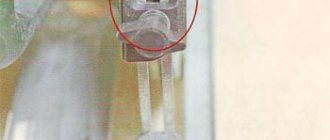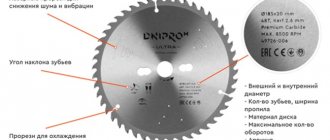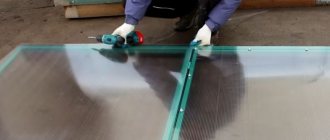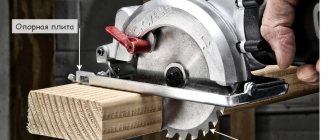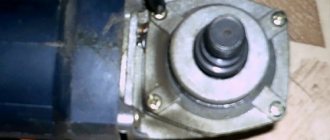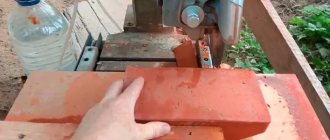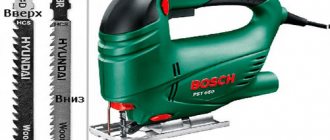To operate a hand-held circular saw, no special qualifications are required. It is enough to try it for the first time, then after a few cuts the user will understand the capabilities of the tool: how quickly it cuts, how hard to press so as not to “strangle” the engine, how the electric saw behaves when starting, how the cord stretches so that it does not get under the saw. This applies to simple sawing, for example, firewood.
It is a little more difficult to make straight cuts and achieve an accurate carpentry cut (plus/minus 1mm or degree). It is difficult to achieve greater accuracy with such a tool, although in principle it is possible. But such tolerances are acceptable in most cases, taking into account the fact that wood can dry out and swell, changing volume and dimensions with a large amplitude (up to 10%). For jewelry precision, other tools are used, including fine-tooth hand saws.
How to set up a saw for an even cut?
The saw blade must be strictly perpendicular to the support platform. This can be seen both in the position of the disk and in the degree scale on the adjusting arc. If the disk is at an angle:
- The locking screw is released.
- The platform tilts to the desired position.
- The screw is fixed.
You should be more careful with tightening. On some models, over-tightening can strip the threads or break off the head.
Then it depends on how and what to cut.
across the board
When cutting in this way, the length of the workpiece must be accurate. Use a tape measure to measure the desired size. Two marks are made with a pencil (marker, sharp object) - at the beginning of the future cut and at the end. The marks are connected by a line. This is the place of the future cut.
On the front part (end) of the platform of each manual circular saw there is a notch. It is located opposite the disk and shows where the cut will go. The notch is aligned with the cut marking and sawed, making sure that the notch follows the marking.
On different hand saws, the cut can be shifted 1-2 mm to the left or right of the mark. Therefore, when using a new saw for the first time, you should try it on unnecessary workpieces where the cut will actually go.
Sometimes it is more convenient to make a marking strip not at the place of the cut, but along the left edge of the platform. Then it will be easier to control the accuracy of the cut. With this marking, the full length of the workpiece is marked, the saw blade is placed against it, and a mark is made on the left along the edge of the platform.
When sawing problematic workpieces (hard, thick, steamed or twisted wood with twisted fibers), there is a possibility that the blade will move away from the mark. In such cases, instead of a mark, a guide block is screwed from the edge of the platform with screws or pressed with clamps. They saw, pressing the platform to the block.
Board along
The easiest way is to make a cut along the entire length on an edged board. To do this, use a support bar on two rods, which is included in the delivery of most models. Also, it is also called a rip fence.
Rip fence
The rods are inserted into the eyes on the platform. Set the desired cutting width and secure the rods with screws. They saw by pressing the support bar against the edged board. Pencil markings are not needed.
They are required when you need to cut a wedge-shaped blank from an edged board (one end is wider, the other is narrower) and for cutting along or trimming the wane of an unedged board. In these cases, a circular saw is used to follow the markings, similar to the cross-cut described above. But we must remember that longitudinal cuts are many times longer than transverse ones.
At the same time, the engine operates with a fairly large load, especially on thick boards (35-50 mm). Therefore, they saw, moving the circular saw at such a speed that the engine does not lose speed, and the disk has time to select the wood and throw sawdust out of the cut.
Hacksaw - simplicity and safety
A hacksaw is a simple tool that is quite suitable for the job. And although the cutting speed is low and considerable physical effort is required, such a saw is the most acceptable option for home use.
to cut wood correctly The main condition for a high-quality cut of the material is to make the cut correctly. To simplify the task, you can use a regular flat block, which is used as a guide.
The question often arises of how smoothly with a hacksaw at an angle. For this purpose, a special carpentry device is used - a miter box. Moreover, it will help not only to make a cut at the desired angle, but will also allow any beginner to cut the board smoothly.
You can also saw off the timber with a hacksaw. The only problem when working with such a workpiece is that you have to put in a lot of effort.
The last option is to use an angle grinder with a wheel with teeth installed for the work. But since the “grinder” is not intended for cutting wood, this method can only be used as a last resort: attempts to cut a board can result in serious consequences. It’s better to use a hacksaw - it’s labor-intensive, but safe.
The hand saw must be driven, otherwise it will start to “walk”. And this must be understood literally, since wood is a living material whose behavior is unpredictable. But the sawing process itself can be complicated due to knots, cracks, hard growth rings, high humidity and high resin content.
READ Stator For Hand Circular Saw
It is because of these reasons that there is no universal tool capable of taking into account all the vagaries of wood, but various special saws can be used for these purposes. The shape and order of alternation of their teeth are not determined by the material. from which the saw blade was made, and its purpose. Some of these tools are designed for cutting in a straight line, the other, on the contrary, is better to go in a circle.
What devices should I use with a circular saw for an even cut?
In addition to the complete guide bar, guide bars of various designs are used together with manual circular saws. With their help, you can evenly trim both edged and unedged boards without pencil markings.
The difference between tires and a guide bar is that the bar moves along the already cut, even edge of the board. And the guide rail is installed on top of the board and at the required distance. The electric saw moves along the bar or inside the bar, depending on the design of the guide. Tires come in two fundamentally different options.
- A flat plane along which the saw moves.
- The grooved plane as the saw blade moves inside the bar.
The first option is the simplest. As such a guide rail, you can use available materials - a flat block, a rail, a corner.
Dozens of varieties of such devices are offered for sale. There are also many videos on the Internet on how to make guides for such work with your own hands.
We also recommend reading an interesting article with tips that will help you choose a circular saw.
Saw a sheet of plywood with full support from below
It is best to do this on the floor. Of course, you can do it on these auxiliary sawhorses, but if you want to get the highest quality cut, then still do it on the floor.
Place several boards to size under a sheet of plywood and, having measured the part to be sawn, lay a guide on top of the plywood and secure it with clamps. This technique will give you a guarantee that at the end of sawing a piece of plywood will not break off, and it will not move anywhere during the process.
The boards should be the same thickness and should be laid across the cut, as in the photo on the right. Yes, you will have to sacrifice several boards, but the cut in them will not be deep, and why, read the next tip.
Techniques for proper sawing at home
It is important to use the correct drive. For stationary machines, disks for longitudinal sawing differ from transverse sawing in the shape of the tooth and the sharpening angle. For manual circular saws there is no such fundamental division. You can use one disc for sawing lengthwise and crosswise.
At the same time, the disk for longitudinal and transverse sawing should be “rare-toothed”, have few teeth - from 12 to 24, depending on the diameter of the disk and the model. Discs with fine, frequent teeth are designed for a clean cut, but on long longitudinal cuts they cut slowly and overheat.
The thickness of the disc depends on the workpiece. A thin blade cuts faster, less wood is removed, and the load is reduced. But on thick hardwood workpieces, a thin disk can overheat, turn blue, lose its hardening and fail. Also, thin discs tend to move away from the markings and “wiggle” the cut.
Unlike stationary circular saws with motors up to 5 kW (10 kW or more on industrial ones) and significant inertial acceleration of the shaft, a hand-held electric saw has a smaller power reserve. Therefore, they saw with them slowly, calmly, avoiding a decrease in speed and overheating of the engine.
At an angle of 90 and 45 degrees
All manual circular saws have the ability to tilt the platform. Due to this, sawing at an angle from 90 to 45 degrees is possible. On some models and at a sharper angle.
Setting the desired angle is simple: the screw is released, the desired angle is set along an arc with degrees, and the screw is fixed. It should be remembered that the maximum depth of cut decreases when sawing at an angle. For example, if at a right angle you can completely cut a workpiece 60 mm thick, then at an angle only 45 mm.
Sawing at an angle is more difficult because the blade also cuts the wood fibers at an angle, which increases friction and resistance. The teeth of the disc must be sharpened, otherwise the wood may burn or blacken. Otherwise, sawing at an angle is carried out in exactly the same way as the straight cut described above.
Beam 150x150 and 100x100 along
The cutting depth of manual circular saws does not allow cutting through material 10-15 cm thick. The maximum for most models is 60-75 mm. However, it is possible to split timber 100x100 and even 150x150 along the length if you make two cuts on opposite sides.
The cut is made along the guide bar, just as when cutting an edged board. Then the timber is turned 180 degrees and a second cut is made. In this case, an unevenness will necessarily form at the junction of the cuts. This cannot be avoided.
Even if the beam was smooth and the cut was made exactly along the guide. A deviation of the opposite surfaces of the beam of 1-2 degrees is enough, and unevenness appears at the junction of the cuts. And such deviations are inevitable even due to lint on the wood.
Problems with this kind of sawing: the disc is completely hidden in the array, the ends of the teeth do not come out and do not cool in the air, friction is maximum over the entire area of the disc, ejection of sawdust is difficult. Therefore, there is a high probability of overheating of the disk and motor.
It is best to make a sawmill from a chainsaw for such tasks; the costs are low, but the result is good, especially cutting accuracy and productivity.
They cut intermittently, making sure that the blade and motor do not overheat. Such cutting according to the load does not correspond to the purpose of manual circular saws and is performed on sawmills or stationary circular saws. If there is a great need, you can unravel several beams of large cross-section, but a manual circular saw cannot work in this mode for a long time.
Chipboard and chipboard without chips
For sawing laminated chipboard (LDSP) sheets, as well as MDF, special machines with an additional scoring disc are used. If you don’t have such a machine in your home workshop, you can use the principle of its operation and cut the sheets using a regular circular saw.
The principle of operation of the scoring disc: it makes a shallow cut of the cladding by 1-1.5 mm, and rotates in the opposite direction. The main blade then completes the cut. The craftsmen tried sawing laminated chipboard using ordinary hand-held and stationary circular saws using the same principle, as follows:
- The position of the support platform sets the cutting depth to 1-1.5 mm.
- The cut is made so that the disc is sawed with the reverse side. A manual circular saw is turned over backwards; on a stationary circular saw, the sheet is launched from the reverse side.
- After cutting the cladding, the sheet is finished off in the usual way, on the same side from which the fine cut was made. In this case, the depth of the cut is set so that the disc comes out of the sheet to the height of the tooth.
Disc for sawing laminated chipboard
This method may not be suitable for some types of laminate. For example, the “vitreous” coating on old Soviet furniture behaves differently when cut than a more elastic laminate. Therefore, it is advisable to make a test cut on an unnecessary workpiece.
There are other ways to cut without damage.
- The cut area is sealed with tape or self-adhesive tape. During cutting, the tape holds the edges of the laminate and prevents pieces of the cladding from breaking out. The method does not always work; a lot depends on the type of laminate, disc, and speed.
- The future cut is drawn, cutting through the laminate, with a sharp tool. The method can help if you can cut through the cladding and then move the disk exactly along the cut location.
Plywood without chips
When cutting, plywood is pulled out from below the cut. This happens because when the tooth pressure is applied from above, the plywood particles are held by the lower layers of the sheet. The bottom layer of plywood does not hold anything in place, and tears and chips are possible on it. This can be avoided if you saw in exactly the same ways as described above as laminated chipboard and MDF sheets.
In this case, it is advisable to use a universal or special disk with fine, frequent teeth. They create a more uniform load than thin-toothed discs and are therefore less likely to chip.
If the circular machine has a speed control function, they are set to maximum. The higher the speed of the discs, the less it tears the material.
Log on boards
Sawmills are designed for sawing logs. Using a circular saw, you can dissolve a small amount of logs with a diameter of 15-20 cm in case of emergency.
To do this, the wane is removed from two opposite sides of the log or the slab is cut down (with an ax, a circular saw with a large disk, a chain saw, a powerful jointer) so that the surfaces are smooth, like a beam. The result is a gun carriage or block that looks like a thick unedged board or timber cut on both sides.
Next, the material is sawed in the same way as described above, like 100x100 or 150x150 timber.
The operation is labor-intensive and low-productivity. At the same time, it is difficult to obtain the correct geometry of the board, and the tool experiences large overloads.
How to cut an unedged board?
Trimming the wane of a board with a manual circular saw can be done in two ways:
- By marking with a pencil (marker, sharp tool, etc.).
- Along the guide. To do this, a block, corner or factory guide rail is attached to the board with clamps or self-tapping screws. They saw by pressing the edge of the saw platform against the guide.
Cutting along a guide usually produces a smoother cut.
We also recommend reading a useful article with reviews of the most popular and best circular saws for the home.
SAW CROSSLY
For cutting at an angle, an aluminum corner 50 x 50 x 2 mm was useful. I press it with clamps to the board that needs to be sawed. In this case, it is necessary to take into account the distance from the edge of the saw base to the saw blade.
Instead of a corner, I sometimes used a rectangular aluminum profile 40 x 20 x 2 mm, 1 m long.
One day I found an old locksmith’s corner with a steel shelf in the barn. With its help, it turned out to be convenient to make cuts at right angles, since the shelf is well fixed at the edge of the board.
What can you cut with a circular saw, and what about metal and concrete?
You can use a hand-held circular saw to cut anything that can cut the disk that sits on it. If the disc is intended for sawing wood, plywood, fiberboard, chipboard, chipboard, MDF, plastic, plasterboard, plywood, then all this is sawed.
If you can find a suitable blade for outer and seat diameters for metal, concrete, etc., then you can cut these materials as well. At the same time, we must remember that the speed of a circular saw is lower than that of an angle grinder. As a result, it will cut more slowly and the disc will wear out faster.
In some cases, sawing with a manual circular saw is more convenient and safer, since it has a support platform with degrees of adjustment in tilt and depth.
Separately, it must be said that today circular hand saws specifically for cutting hard materials have appeared on sale. They have higher speeds, are protected from dust from slate, brick or concrete getting into the engine, the mounting diameters are adapted to the standards of discs for concrete, metal, etc.
Operating rules
A circular saw is a useful tool. You need to work with it depending on a number of reasons:
- When spraying, the depth must be set 2 mm greater than the thickness of the material.
- DO NOT remove the bottom cover. When you try to remove it, the disk goes into the part and damages not only it, but also the surface of the workbench. You should first carefully consider how the tool will behave during operation.
- The disc must NOT touch the workbench. To avoid this, slightly raise the cutting part. Cutting into wood must be done at high speeds. This will prevent the risk of loss and allow the part to be quickly sprayed.
- The material should be on the desktop. It is not allowed to work with it in a suspended state.
- Hold the tool firmly and do not let it wobble from side to side.
- To begin the operation Fix the workpiece. If safety rules are not followed, the part moves together with the equipment, which is unacceptable.
Why does it cut crookedly?
The disc cuts the line to which it is directed. In this case, the tool should be held or pressed against the guide firmly enough so that it does not move to the side.
If, despite all efforts, the cut turns out to be crooked, the reason is an unusable disc. A scorched disc with double-sided blue spots may begin to wobble at the slightest heat. If the teeth on one side are normal, but on the other they are knocked out or dull, the saw may pull in one direction, no matter how hard you try to hold it.
